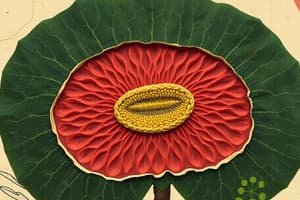Podcast
Questions and Answers
Which type of root has a star-shaped xylem?
Which type of root has a star-shaped xylem?
- Neither Dicotyledonous nor Monocotyledonous roots
- Both Dicotyledonous and Monocotyledonous roots
- Monocotyledonous root
- Dicotyledonous root (correct)
Collenchyma cells have thin cell walls that provide no support to plants.
Collenchyma cells have thin cell walls that provide no support to plants.
False (B)
What type of supporting tissue is characterized by thickened walls and provides rigidity?
What type of supporting tissue is characterized by thickened walls and provides rigidity?
Collenchyma
The primary function of xylem tissues is to transport __________ and mineral salts.
The primary function of xylem tissues is to transport __________ and mineral salts.
Match the following types of xylem tissues with their characteristics:
Match the following types of xylem tissues with their characteristics:
Which of these tissues contains cell walls thickened with lignin?
Which of these tissues contains cell walls thickened with lignin?
The phloem tissues are responsible for transporting mainly water.
The phloem tissues are responsible for transporting mainly water.
What is the characteristic feature of the cambium in dicotyledonous roots?
What is the characteristic feature of the cambium in dicotyledonous roots?
What is the primary function of parenchyma tissues in plants?
What is the primary function of parenchyma tissues in plants?
Sclerenchyma cells are living cells that provide flexibility to plants.
Sclerenchyma cells are living cells that provide flexibility to plants.
What characteristic distinguishes dicotyledonous stems from monocotyledonous stems in terms of vascular bundles?
What characteristic distinguishes dicotyledonous stems from monocotyledonous stems in terms of vascular bundles?
The __________ is responsible for the conduction of manufactured food from the leaves to other parts of the plant.
The __________ is responsible for the conduction of manufactured food from the leaves to other parts of the plant.
Match the following plant tissues with their primary functions:
Match the following plant tissues with their primary functions:
Which of the following best describes the function of the cambium in plants?
Which of the following best describes the function of the cambium in plants?
Parenchyma tissues contain chloroplasts for photosynthesis.
Parenchyma tissues contain chloroplasts for photosynthesis.
The __________ provides flexibility or resilience to plants.
The __________ provides flexibility or resilience to plants.
Flashcards
Parenchyma Tissues Function
Parenchyma Tissues Function
Parenchyma tissues provide support, firmness, and turgidity to plants by filling with cell sap. They also store food and water and contain chloroplasts for photosynthesis.
Sclerenchyma Tissue Function
Sclerenchyma Tissue Function
Sclerenchyma gives flexibility, strength, rigidity, and hardness to plants, and is made of dead, lignified cells found in vascular bundles.
Vascular Bundles Function
Vascular Bundles Function
Vascular bundles, made of xylem (water transport) and phloem (food transport), are the major transportation system of plants. The vascular cambium produces xylem and phloem.
Xylem Function
Xylem Function
Signup and view all the flashcards
Phloem Function
Phloem Function
Signup and view all the flashcards
Dicot Stem Structure
Dicot Stem Structure
Signup and view all the flashcards
Monocot Stem Structure
Monocot Stem Structure
Signup and view all the flashcards
Endodermis Function
Endodermis Function
Signup and view all the flashcards
Dicot Root vs Monocot Root
Dicot Root vs Monocot Root
Signup and view all the flashcards
Plant Support Tissue: Parenchyma
Plant Support Tissue: Parenchyma
Signup and view all the flashcards
Plant Support Tissue: Collenchyma
Plant Support Tissue: Collenchyma
Signup and view all the flashcards
Plant Support Tissue: Sclerenchyma
Plant Support Tissue: Sclerenchyma
Signup and view all the flashcards
Xylem Tissue Structure
Xylem Tissue Structure
Signup and view all the flashcards
Xylem Tissue Function
Xylem Tissue Function
Signup and view all the flashcards
Xylem Adaptations to transport
Xylem Adaptations to transport
Signup and view all the flashcards
Study Notes
Plant Supporting Tissues
- Plant tissues provide support for the plant
- Understanding internal structure of stems, leaves, and roots aids in understanding support mechanisms
- Epidermis/Piliferous Layer: Outer covering (leaves/stems) and roots (piliferous layer). Protects inner cells from injury and water loss.
Plant Supporting Tissues (Cont.)
- Cortex: Found between epidermis and vascular bundles in stems/roots. Consists of three tissues:
- Collenchyma (outer): Provides strength and flexibility (bend without breaking)
- Parenchyma (middle): Most abundant, provides support (when vacuoles full of cell sap), firmness (turgidity), storage (food and water). Also contains chloroplasts (photosynthesis) and intercellular spaces for gas exchange.
- Endodermis (inner): Stores starch (turns black with iodine)
Plant Supporting Tissues (Cont.)
-
Sclerenchyma: Dead lignified cells; Provides strength, rigidity, and hardness
-
Vascular Bundles/Tissues: Found in stems/roots inner part; Composed of two components:
- Xylem: Conducts water and mineral salts from soil to leaves/stems
- Phloem: Transports manufactured food from leaves to other parts
Plant Supporting Tissues (Cont.)
-
Cambium: Found between phloem and xylem; produces more xylem and phloem tissues
-
Pith: Central part of dicot stem; Provides rigidity
Dicot vs. Monocot Stems
- Dicot: Vascular bundles arranged in rings, pith present, wide cortex, fewer vascular bundles, has cambium, distinct endodermis
- Monocot: Vascular bundles scattered, absence of pith, absence of cambium, many vascular bundles, no endodermis
Dicot vs. Monocot Roots
- Dicot: Fewer vascular bundles, xylem is star-shaped, pith is absent, cambium is present
- Monocot: Many vascular bundles, xylem is not star-shaped, pith is present, cambium is absent
Types of Supporting Tissues in Plants
- Parenchyma, Collenchyma, Sclerenchyma, Xylem, Phloem fibers
Parenchyma
- Cells become turgid due to water in large vacuoles; Gives support to plants; Rigid cell wall network gives primary support
Collenchyma
- Thickened cell walls that offer rigidity and support
Sclerenchyma
- Cell walls thickened with lignin; Provides rigidity and support to the plant
Xylem Structure
- Long or tabular, lumen present, absence of end walls, dead cells, lignified walls, tracheids present
Xylem Adaptive Features
- Long tubular structure; no cytoplasm; dead cells (without cytoplasm/nucleus) to transport water and mineral salts; Thick, strong, lignified cell walls to support; Lack of cross walls for effective transport
Xylem Functions
- Transport water and mineral ions to plant
Phloem Structure
- Sieve tubes, phloem parenchyma, companion cells, phloem fibers
Phloem Functions
- Transport manufactured food; Support to plant; Help in food storage
Supporting Tissue Functions
- Shape, rigidity, flexibility, support, conduction of water/food
Studying That Suits You
Use AI to generate personalized quizzes and flashcards to suit your learning preferences.



